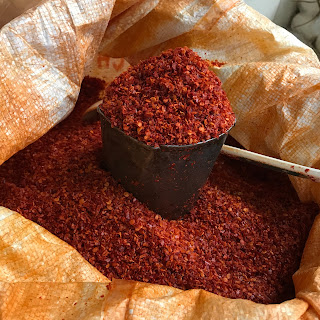Fortunately,
I was well enough to go to the store and get provisions. I was just thinking
chicken noodle soup, but then I remembered the recipe for Bhutanese Chicken
Stew. I saw that recipe when I was collecting recipes for Thanksgiving. The
recipe was easy enough that I can prepare it for the night. Being a stew, I
imagine the prep was not too bad, esp. for a recovering sick person.
We also still
have onions, tomatoes, ginger and garlic – perhaps because Hubby made chicken
soup the other day for me when I was at my worst. I just bought chicken,
chilis, cilantro and more chicken stock to add to the dish. I believe this dish
was not meant to be brothy, but hey… I need soup too.
Since I
was more a dish that I prepared almost “on the fly” and when I was recovering,
I really do not have much intro… I just wanted soup and had inspiration. So,
here’s what I have for now. Let me know what you think.
Bhutanese-Inspired Spicy Chicken Stew
Inspired by Jasha Maroo
Ingredients
- 1 1/2 lb boneless skinless chicken thighs, cut into 1-inch cubes
- 1 medium-size leek, cut into slices
- 1 large tomato, diced
- 1/2 onion, peeled and chopped
- 4 cloves garlics, peeled finely minced
- 2 Tbsp of ginger, finely minced
- 4 chili peppers, seeded if you like and cut into small pieces
- Salt to taste
- 3 cups chicken stock (use less, if you don’t need that much broth)
- 2 Tbsp of oil
- 1 small bunch of cilantro leaves, for garnish
- lime or lemon slices (optional, for garnish)
Directions
- Preheat pot and add in oil. Add in the garlic, ginger, onion, chili, and leeks. Stir-fry until the vegetables are soft (I add a bit salt and pepper at this point to sweat the vegetables).
- Tip in the chicken and tomatoes and continue to stir-fry until the chicken started to turn opaque in color (I add a bit of seasoning here too).
- Pour in the chicken stock and bring to a boil. Lower the heat and cover with the lid and let it gently simmer until the chicken is cooked through.
- Serve warm with a bowl of steamed rice. Garnish the stew with cilantro leaves. Add a squeeze of lime or lemon for a touch of freshness.
Verdict
I love this
dish, love the simplicity and spiciness of the stew. It is very characteristic of the
cuisine of Bhutan.
I could not
call it Jasha Maroo because Jasha Maroo usually uses red peppers (I found out
after looking at Instagram – doh!). I used green because those red peppers
looked threatening. I also made this stew extra brothy on purpose because of
the cold night. Traditionally, the recipe only uses 1 cup of broth. I think I
stopped myself from pouring the entire container.
In subsequent servings, I did my “thing” of adding lemon or lime during serving. This really adds a touch of freshness and citrus note to soups or stews, since they usually cook for a while (I think this took about an hour, maybe a touch more). I think of it as the “Asian” gremolata (without the mincing). Adding lime did add some Southeast Asian notes to it… but hey, it’s one big world.
In subsequent servings, I did my “thing” of adding lemon or lime during serving. This really adds a touch of freshness and citrus note to soups or stews, since they usually cook for a while (I think this took about an hour, maybe a touch more). I think of it as the “Asian” gremolata (without the mincing). Adding lime did add some Southeast Asian notes to it… but hey, it’s one big world.



